
 |
||||
![]()
The T60 Pic du Midi spectrograph
It is operated by the Association T60 and until 1996, before it was moved to another place on the summit due to the new the tourist area created, a classical spectrograph was in use, designed by Daniel Bardin. Since July 2002, the T60 is opened again to amateurs, but the spectrograph is no more in use due to some optical change and mechanical changes on telescope. The collimator lens was a 200mm f/3.2 - we used then a combination of 2 gratings and 2 objective lens: - Jobin-Yvon transmission gratings 6cmx6cm : 300lp/mm and 600lp/mm - Zeiss 50mm f/0.8 and Rodenstock 500mm f/4.6 The preferred association was: - the high dispersion grating 600lp/mm and the 500mm lens, which gave us a sampling of 0.33 angstrom per pixel with a CCD chip from kodak (pixel size is 9 microns) - the low dispersion configuration to get fainter object with the 300lp/mm grating and the 50mm lens. It drives a sampling of 6 angstrom per pixel at a 9 microns pixel size. Or a 18 angstrom by pixel when used with a CCD chip of a 30 microns pixel size like the TH7852. NB: this configuration was designed in the 80's for photo and then adapted for CCD in '88 - The first camera was a C.Buil designed around a TH7852 chip and in '94 we first used an HISIS 22 camera based on the KAF400 CCD chip. At that time, the telescope was not tracking the stars very well, an observer had to stay in the dome to make regular telescope correction to keep the star in the slit. We used to make very long exposure, up to 15 minutes each, sometimes gathering 3 or 4 of them to get a good quality spectrum. Now, we could recommend to break down even more the total exposure time, recording 10 shoots of 1 minute each. This is not stupid with the low noise camera we have now. Last interesting feature is the place where the recording camera is placed. The angle setting is easy to change. This means that different wavelength zone can be explored in a very efficient manner. In spectroscopy, the dilemna is always the same, you have to balance between ligth (i.e. signal to noise ratio) and resolution. The ligth is very precious in astronomy. Consider the time needed to get the image of a faint galaxy. Now, with a spectrograph the same light is spread over the entire CCD. The higher is the resolution, the higher is dispersion th emaller the quantity of ligth is captured by a single pixel...
The T60 is a 60cm newton telescope f/3.5 at the Pic du Pidi Observatory - Pyrénés - France.

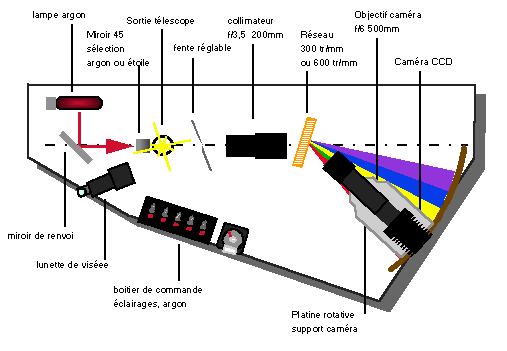
Attached on the telescope tube side, the spectrograph is quite impressive. The first collimator lens is focused to send the slit image to the infinite, the parallel beam cross the transmission grating and the spectrum is formed, ready to be recorded by the CCD camera with an objective lens.
![]()
The T60 spectrograph is a very classical design with a slit, a collimator lens, a transmission grating and a mount to adapt any recording device with an objective lens focused at the infinite.
A spectral calibration lamp is embedded, the Argon lamp is used to provide absolute wavelength calibration.
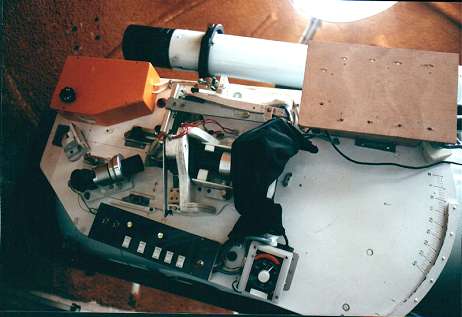
To help for pointing and to keep the star in the tiny slit, the slit itslef is aluminated around and a small refractor is directed to the slit. When pointing an object, the field around the star can be identified by looking in it, and the star is brougth in the slit by making it disappear in the darkeness of the slit.

The slit aperture was set up to the limit where the lines was not shaper but the lines intensity started to decrease. This is adjusted once a time at the beginning of the mission and is dependent of the lens combination.

| Here are some examples of what was achieved: | |
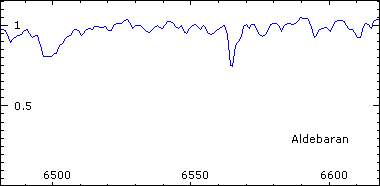 |
Camera TH7852 Sampling 0.975 Angstrom / pixel Grating 600lp/mm - Obj: 500mm H-alpha region |
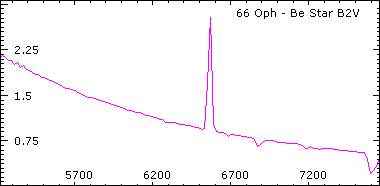 |
Camera TH7852 Sampling 19 Angstrom / pixel Grating 300lp/mm - Obj: 50mm H-alpha line in emission |
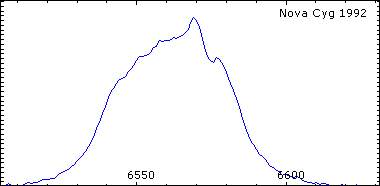 |
Camera TH7852 Sampling 0.975 Angstrom / pixel Grating 600lp/mm - Obj: 500mm H-alpha line of the Nova |
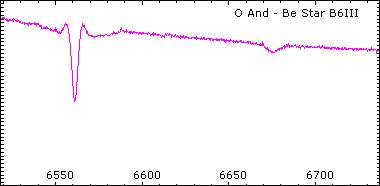 |
Camera HISIS 22 Sampling 0.33 Angstrom / pixel Grating 600lp/mm - Obj: 500mm H-alpha (6563A) and HeI (6678A) |
![]()
You can use it for almost all types of observations: visual, with webcam, with CCD, and with spectrograph... providing a better equatorial mount than the original one in some occasion. See some examples. So why not trying spectroscopy ? C.Buil indicated in his web site a very simple spectrograph design, very light and easy to make for a non-mechanical person, with just a transmission grating, a barlow and a CCD camera with an objective lens. The used elements was: - ETX photo T-mount adaptor Details of the pre-assembly spectrograph: the Spectrograph with the T-mount with the barlow inside, the grating support and the wood plate and the Audine camera equipped with the Nikon Objective Details of the mounting of the camera at a pre-defined angle to aim at the required wavelength zone. Final assembly - reading to be mount on the GP/DX equatorial mount Some computation To correctly design the spectrograph, some basic computation can be performed to select the best objective lens and the right camera angle position to aim at the required wavelength zone. I used C.Buil's software to compute the spectrograph characteristics. Final adjustment on the sky First, the objective lens shall be adjust to the infinite. This shall be done on the sky, by aiming stars and making the focus. When done, the camera is locked on the wood plate at the zero angle to help for finding stars. When the star is located, the camera can be moved to the pre-defined angle and the final focus at the telescope level shall be performed to balance for chromatism. The focus on blue zone can be different from red zone, due to the objective perfomances, and a balanced focus shall be made to get the best of the entire spectrum. Finally I had to adapt alpha and delta coordinates so that the entire spectrum and the rigth wavelength domain is centered on the CCD. At acquisition, only a sub-image zone was recorded around the spectrum to accelerate spectra acquisition and eliminate as much as possible the background. This spectrograph does not have a slit, so other close stars can be producing spectra around. Above is the Vega spectrum image, a collection of 9 exposures of 30s, all pre-processed, registered and added with Iris software. Once opened in Visual Spec, the following profile is obtained (see the blue profile): To calibrate the spectrum in wavelength, I used the atmospheric line 02 at 7604 angstrom, very deep, and then the Hydrogenous Balmer lines. The wavelength relation was not linear, so I had to performed a non-lin calibration in Vspec. To complete the spectrum processing, the profile intensity shall be corrected from the CCD response. it is achieved by using the normalized A0V spectrum from the Vspec library. By dividing the raw profile by the reference one, and after the lines elimination and applying a smoothing function the response profile is obtained. This profile is kept aside to correct all the others spectra which will be acquired in the night.
The ETX 90 is a fun telescope !
- T-mount to 42mm adaptor
- Televue Barlow x2
- Audine camera front-end plate, ordered to essential electronic
- Grating from Jeulin, 300tr/mm and 100tr/mm
- Nikon Objective lenses: 35mm f/
- A home-made bague to adapt Nikon lens to 42 mount of the Audine camera
- Audine camera with KAF400 CCD chip
- a wood plate
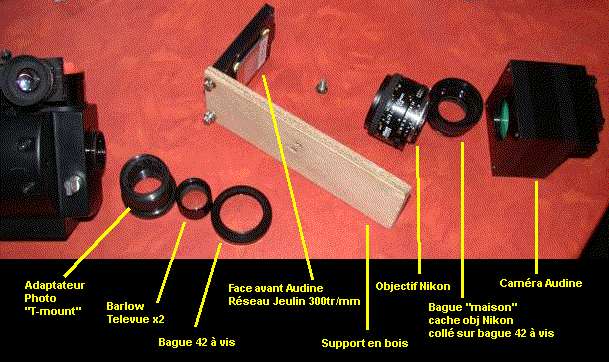

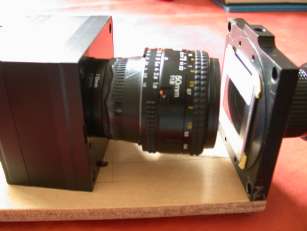


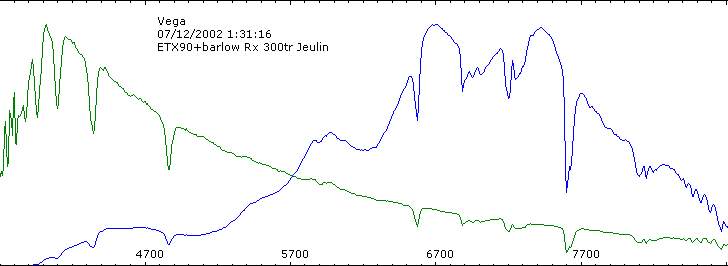
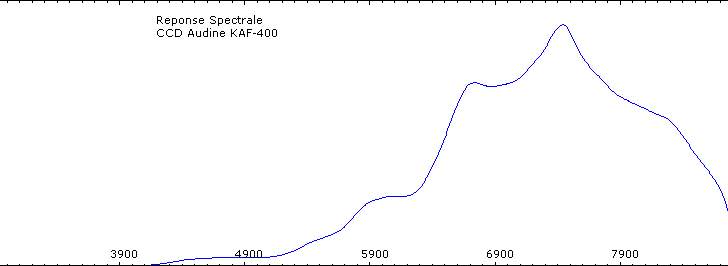
This spectrograph with the ETX90 is not extremelly resolving. It is also limited to brigth objects. But it is sufficient to identify emission lines in Be stars. Below is a summary of the objects recorded during that night. Refer to the section of the spectra library to get access to the observations data.

From right to left and top to bottom the stars are:
Vega - Eta Uma - Gamma Cas - Beta Cep - Kappa Dra -Th CrBG Cas is a Be star with a strong H-alpha emission line.
All the spectra have the same exposure time and are represented at the same scale.
![]()
Christian Buil's spectrographs
Christian is also the designer of the free software Iris and participated to the design of the CCD Audine camera (cloned as Genesis camera in US). see C.Buil site at http:\\www.astrosurf.com\buil\
Christian is a French amateur who greatly popularize the spectroscopy in the amateur world by providing several types of spectrograph design. From very low and basic design with a simple transmission grating to a more complex spectrograph with slit and multiple objectives, the list is constinously evolving with numerous examples, drawings, pictures and observations reports.